Providing School Meals to All Students Free of Charge during the COVID-19 Pandemic and Beyond: Challenges and Benefits Reported by School Foodservice Professionals in California
Abstract
1. Introduction
2. Materials and Methods
2.1. Participants
2.2. Survey
2.3. Stratification Variables
2.4. Statistical Analysis
3. Results
3.1. Sample Characteristics
3.2. Changes after Implementing USM during the COVID-19 Pandemic in the SY 2021–22
3.3. Challenges Implementing USM during the COVID-19 Pandemic in the SY 2021–22
3.4. Meal Reimbursements Relative to Costs of Implementing USM during the COVID-19 Pandemic in the SY 2021–22
3.5. Factors Driving a Financial Deficit for SFAs during the COVID-19 Pandemic in the SY 2021–22
3.6. Concerns about the Future Operation of California’s USM
3.7. Additional Resources or Information Needed to Implement California’s USM in the SY 2022–23
4. Discussion
Strengths and Limitations
5. Conclusions
Supplementary Materials
Author Contributions
Funding
Institutional Review Board Statement
Informed Consent Statement
Data Availability Statement
Acknowledgments
Conflicts of Interest
References
- U.S. Department of Agriculture. The School Breakfast Program Fact Sheet. Available online: https://fns-prod.azureedge.us/sites/default/files/resource-files/SBPfactsheet.pdf (accessed on 23 May 2022).
- U.S. Department of Agriculture. The National School Lunch Program Fact Sheet. Available online: https://fns-prod.azureedge.us/sites/default/files/resource-files/NSLPFactSheet.pdf (accessed on 23 May 2022).
- Corkins, M.R.; Daniels, S.R.; de Ferranti, S.D.; Golden, N.H.; Kim, J.H.; Magge, S.N.; Schwarzenberg, S.J. Nutrition in Children and Adolescents. Med. Clin. North Am. 2016, 100, 1217–1235. [Google Scholar] [CrossRef] [PubMed]
- Cohen, J.F.W.; Hecht, A.A.; McLoughlin, G.M.; Turner, L.; Schwartz, M.B. Universal School Meals and Associations with Student Participation, Attendance, Academic Performance, Diet Quality, Food Security, and Body Mass Index: A Systematic Review. Nutrients 2021, 13, 911. [Google Scholar] [CrossRef] [PubMed]
- Thomson, J.L.; Tussing-Humphreys, L.M.; Goodman, M.; Landry, A. Diet quality in a nationally representative sample of American children by sociodemographic characteristics. Am. J. Clin. Nutr. 2018, 109, 127–138. [Google Scholar] [CrossRef] [PubMed]
- Micha, R.; Karageorgou, D.; Bakogianni, I.; Trichia, E.; Whitsel, L.P.; Story, M.; Peñalvo, J.L.; Mozaffarian, D. Effectiveness of school food environment policies on children’s dietary behaviors: A systematic review and meta-analysis. PLoS ONE 2018, 13, e0194555. [Google Scholar] [CrossRef]
- Mikkilä, V.; Räsänen, L.; Raitakari, O.T.; Pietinen, P.; Viikari, J. Consistent dietary patterns identified from childhood to adulthood: The Cardiovascular Risk in Young Finns Study. Br. J. Nutr. 2007, 93, 923–931. [Google Scholar] [CrossRef] [PubMed]
- Tan, M.L.; Laraia, B.; Madsen, K.A.; Johnson, R.C.; Ritchie, L. Community Eligibility Provision and School Meal Participation among Student Subgroups. J. Sch. Health 2020, 90, 802–811. [Google Scholar] [CrossRef]
- U.S. Department of Agriculture. National School Lunch Program. Available online: https://www.ers.usda.gov/topics/food-nutrition-assistance/child-nutrition-programs/national-school-lunch-program/ (accessed on 23 May 2022).
- U.S. Department of Agriculture. School Breakfast Program. 2021. Available online: https://www.ers.usda.gov/topics/food-nutrition-assistance/child-nutrition-programs/school-breakfast-program/ (accessed on 16 September 2022).
- U.S. Department of Agriculture. National School Lunch Program: Participation and Lunches Served. Available online: https://fns-prod.azureedge.us/sites/default/files/resource-files/slsummar-5.pdf (accessed on 1 June 2022).
- Global Child Nutrition Foundation. School Meal Programs Around the World—Report Based on the Global Survey of School Meal Programs. 2019. Available online: https://survey.gcnf.org/wp-content/uploads/2021/03/GCNF_School-Meal-Programs-Around-the-World_Report_2021_Final.pdf (accessed on 16 September 2022).
- Liu, J.; Micha, R.; Li, Y.; Mozaffarian, D. Trends in Food Sources and Diet Quality Among US Children and Adults, 2003-2018. JAMA Netw. Open 2021, 4, e215262. [Google Scholar] [CrossRef]
- Potamites, E.; Gordon, A. Children’s Food Security and Intakes from School Meals: Final Report; 2010. Available online: https://naldc.nal.usda.gov/download/42320/pdf (accessed on 16 September 2022).
- Au, L.E.; Gurzo, K.; Gosliner, W.; Webb, K.L.; Crawford, P.B.; Ritchie, L.D. Eating School Meals Daily Is Associated with Healthier Dietary Intakes: The Healthy Communities Study. J. Acad. Nutr. Diet. 2018, 118, 1474–1481.e1. [Google Scholar] [CrossRef]
- Kinderknecht, K.; Harris, C.; Jones-Smith, J. Association of the Healthy, Hunger-Free Kids Act With Dietary Quality Among Children in the US National School Lunch Program. JAMA 2020, 324, 359–368. [Google Scholar] [CrossRef]
- U.S. Department of Agriculture. Healthy Hunger-Free Kids Act. Available online: https://www.fns.usda.gov/cn/healthy-hunger-free-kids-act (accessed on 1 June 2022).
- Gearan, E.C.; Fox, M.K. Updated Nutrition Standards Have Significantly Improved the Nutritional Quality of School Lunches and Breakfasts. J. Acad. Nutr. Diet. 2020, 120, 363–370. [Google Scholar] [CrossRef] [PubMed]
- Vernarelli, J.A.; O’Brien, B. A Vote for School Lunches: School Lunches Provide Superior Nutrient Quality than Lunches Obtained from Other Sources in a Nationally Representative Sample of US Children. Nutrients 2017, 9, 924. [Google Scholar] [CrossRef] [PubMed]
- Gosliner, W.A. The National School Lunch Program: Ideas, Proposals, Policies, and Politics Shaping Students’ Experiences with School Lunch in the United States, 1946—Present; University of California: Berkeley, CA, USA, 2013. [Google Scholar]
- Lovellette, G.; Murdoch, J.; Nisar, H.; Wallace-Williams, D.; Vachon, M.; Enver, A.; Logan, C.; Shivji, A.; Villarreal, M. UDSA Community Eligibility Provision Characteristics Study: Final Report. 2022. Available online: https://fns-prod.azureedge.us/sites/default/files/resource-files/CEPSY2016-2017.pdf (accessed on 16 September 2022).
- U.S. Department of Agriculture. Provisions 1, 2, and 3 | Food and Nutrition Service. Available online: https://www.fns.usda.gov/cn/provisions-1-2-and-3 (accessed on 23 May 2022).
- Food Research and Action Center. Community Elegibility: The Key to Hunger-Free Schools School Year 2020–2021. 2021. Available online: https://frac.org/wp-content/uploads/CEP-Report-2021.pdf (accessed on 16 September 2022).
- U.S. Department of Agriculture. Child Nutrition COVID-19 Waivers from Previous School Years. Available online: https://www.fns.usda.gov/fns-disaster-assistance/fns-responds-covid-19/child-nutrition-covid-19-waivers-previous-school-years (accessed on 27 May 2022).
- U.S. Congress. H.R.6201—116th Congress (2019–2020)—Families First Coronavirus Response Act. Available online: https://www.congress.gov/bill/116th-congress/house-bill/6201/text (accessed on 16 September 2022).
- Food Research and Action Center. Large School District Report Operating School Nutrition Programs During the Pandemic. 2022. Available online: https://frac.org/wp-content/uploads/large-school-district-report-2022.pdf (accessed on 16 September 2022).
- U.S. Department of Agriculture. SY 2021-22 Waivers and Flexibilities. Available online: https://www.fns.usda.gov/disaster/pandemic/cn-2021-22-waivers-and-flexibilities (accessed on 27 May 2022).
- U.S. Department of Agriculture. Child Nutrition COVID-19 Waivers. Available online: https://www.fns.usda.gov/fns-disaster-assistance/fns-responds-covid-19/child-nutrition-covid-19-waivers (accessed on 27 May 2022).
- Gutierrez, E. The Majority of Adults Support Permanent, Free School Meals for All Students; Urban Institute: 2022. Available online: https://www.urban.org/sites/default/files/2022-06/The%20Majority%20of%20Adults%20Support%20Permanent%2C%20Free%20School%20Meals%20for%20All%20Students%20.pdf (accessed on 16 September 2022).
- California Department of Education. Changes to Independent Study Requirements. Available online: https://www.cde.ca.gov/sp/eo/is/changesisab130.asp (accessed on 27 June 2022).
- California Department of Education. California Universal Meals. Available online: https://www.cde.ca.gov/ls/nu/sn/cauniversalmeals.asp#:~:text=Beginning%20in%20School%20Year%20(SY,Program%20(NSLP)%20and%20School%20Breakfast (accessed on 27 May 2022).
- Gingerella, B. Vermont Governor Signs Universal Free Meals Bill into Law. Available online: https://www.foodservicedirector.com/operations/vermont-governor-signs-universal-free-meals-bill-law (accessed on 3 June 2022).
- Bylander, A. California and Maine Lead the Way with Healthy School Meals for All. 2021. Available online: https://frac.org/blog/california-and-maine-lead-the-way-with-healthy-school-meals-for-all (accessed on 16 September 2022).
- Hecht, A.A.; Stuart, E.A.; Porter, K.M.P. Factors Associated with Universal Free School Meal Provision Adoption among US Public Schools. J. Acad. Nutr. Diet. 2021, 122, 49–63. [Google Scholar] [CrossRef] [PubMed]
- Asada, Y.; Ma, S.M.; Chriqui, J.F. Addressing Equity in Rural Schools: Opportunities and Challenges for School Meal Standards Implementation. J. Sch. Health 2020, 90, 779–786. [Google Scholar] [CrossRef] [PubMed]
- U.S. Department of Agriculture. School Nutrition and Meal Cost Study—School Meal Costs and Revenues; Office of Policy Support: Alexandria, VA, USA, 2019.
- Hoffman, J.A.; Rosenfeld, L.; Schmidt, N.; Cohen, J.F.; Gorski, M.; Chaffee, R.; Smith, L.; Rimm, E.B. Implementation of Competitive Food and Beverage Standards in a Sample of Massachusetts Schools: The NOURISH Study (Nutrition Opportunities to Understand Reforms Involving Student Health). J. Acad. Nutr. Diet. 2015, 115, 1299–1307.e2. [Google Scholar] [CrossRef] [PubMed]
- U.S. Department of Agriculture. Results of the U.S. Department of Agriculture, Food and Nutrition Service-Administered School Food Authority Survey on Supply Chain Disruptions. 2022. Available online: https://fns-prod.azureedge.us/sites/default/files/resource-files/FNS-Survey-Supply-Chain-Disruptions.pdf (accessed on 16 September 2022).
- U.S. Department of Agriculture. USDA Distributes $1.5 Billion to Strengthen School Meal Program; Service, F.a.N., Ed. 2021. Available online: https://www.fns.usda.gov/news-item/usda-0273.21 (accessed on 16 September 2022).
- California Department of Education. California Healthy Kids Study Key Informant Interview Guide for School Food & Nutrition Environment; 2015. Not available online.
- Centers for Disease Control and Prevention. School Health Policies and Programs Study 2006—Food Service District Questionnaire; Burlington, VT, USA. 2006. [Google Scholar]
- Rider, C.; Linares, A.; Kao, J.; Becker, C.; Woodward-Lopez, G. Assessing Healthful Eating and Physical Activity Practices in Places Children Learn. J. Ext. 2021, 58, 28. [Google Scholar]
- Ritchie, L.D.; Wakimoto, P.; Woodward-Lopez, G.; Thompson, F.E.; Loria, C.M.; Wilson, D.K.; Kao, J.; Crawford, P.B.; Webb, K.L. The Healthy Communities Study Nutrition Assessments. Am. J. Prev. Med. 2015, 49, 647–652. [Google Scholar] [CrossRef] [PubMed]
- California Department of Education. DataQuest. Available online: https://dq.cde.ca.gov/dataquest/ (accessed on 23 May 2022).
- California Department of Education. Free or Reduced-Price Meal (Student Poverty) Data—Accessing Educational Data. Available online: https://www.cde.ca.gov/ds/ad/filessp.asp (accessed on 12 May 2022).
- Hailu, A.; Wasserman, C. Guidelines for Using Rural-Urban Classification Systems for Community Health Assessment; Washington State Department of Health: 2016. Available online: https://doh.wa.gov/sites/default/files/legacy/Documents/1500//RUCAGuide.pdf (accessed on 16 September 2022).
- U.S. Department of Agriculture. Rural-Urban Commuting Area Codes. Available online: https://www.ers.usda.gov/data-products/rural-urban-commuting-area-codes/ (accessed on 23 May 2022).
- U.S. Department of Agriculture. Professional Standards for State and Local School Nutrition Programs Personnel as Required by the Healthy, Hunger-Free Kids Act of 2010. Available online: https://www.federalregister.gov/documents/2015/03/02/2015-04234/professional-standards-for-state-and-local-school-nutrition-programs-personnel-as-required-by-the (accessed on 16 September 2022).
- U.S. Department of Agriculture. Summer Food Service Program; 2021 Reimbursement Rates; 7033052537. 2020. Available online: https://www.govinfo.gov/content/pkg/FR-2020-12-31/pdf/2020-29093.pdf (accessed on 16 September 2022).
- Food Research and Action Center. The Reach of Breakfast and Lunch: A Look at Pandemic and Pre-Pandemic Participation. 2022. Available online: https://frac.org/blog/the-reach-of-breakfast-and-lunch-report (accessed on 16 September 2022).
- Buttorff, C.; Ruder, T.; Bauman, M. Multiple Chronic Conditions in the United States; RAND Corporation: Santa Monica, CA, USA, 2017; 10.7249/TL221. [Google Scholar]
- The Rockefeller Foundation; Center for Good Food Purchasing. True Cost of Food: School Meals Case Study. 2021. Available online: https://www.rockefellerfoundation.org/wp-content/uploads/2021/11/True-Cost-of-Food-School-Meals-Case-Study-Full-Report-Final.pdf (accessed on 16 September 2022).
- Flores, L.; de Blasis, T.; Shioiri-Clark, M.; Polonsky, H. Nourishing Learners: A Report on School Meals and Education During COVID-19. Food Corps: USA, 2021. Available online: https://foodcorps.org/wp-content/uploads/2021/09/Nourishing-Learners-FINAL.pdf (accessed on 16 September 2022).
- World Wildlife Fund. Food Waste Warriors: A Deed Dive into Food Waste in US Schools. 2019. Available online: https://c402277.ssl.cf1.rackcdn.com/publications/1271/files/original/FoodWasteWarriorR_CS_121819.pdf?1576689275 (accessed on 16 September 2022).
- California Department of Education. 2021–22 CNP Reimbursement Rates. Available online: https://www.cde.ca.gov/ls/nu/rs/rates2122.asp (accessed on 15 July 2022).
- Long, M.; Marple, K.; Andreyeva, T. Universal Free Meals Associated with Lower Meal Costs While Maintaining Nutritional Quality. Nutrients 2021, 13, 670. [Google Scholar] [CrossRef] [PubMed]
- U.S. Bureau of Labor Statistics. The Economics Daily, Consumer Price Index: 2021 in Review. Available online: https://www.bls.gov/opub/ted/2022/consumer-price-index-2021-in-review.htm (accessed on 15 July 2022).
- U.S. Department of Agriculture. Summary Findings Food Price Outlook. 2022. Available online: https://www.ers.usda.gov/data-products/food-price-outlook/summary-findings/#:~:text=In%202021%2C%20food%2Dat%2D,of%203.9%20percent%20in%202021 (accessed on 15 July 2022).
- U.S. Department of Agriculture. Waiver to Allow Fiscal Action Flexibility for Meal Pattern Violations Related to COVID-19 Supply Chain Disruptions Impacting School Meals in School Year 2022–2023—EXTENSION. Available online: https://www.fns.usda.gov/cn/covid-19-child-nutrition-response-110 (accessed on 16 September 2022).
- U.S. Congress. Keep Kids Fed Act of 2022. S.2089—117th Congress (2021–2022). Available online: https://www.congress.gov/bill/117th-congress/senate-bill/2089#:~:text=The%20bill%20authorizes%20USDA%20to,year%20beginning%20in%20July%202022 (accessed on 15 July 2022).
- U.S. Department of Agriculture. Nationwide Waiver of the Summer Sponsor Application Deadline and to Allow Reimbursement for Meals Served Prior to Notification of Approval for Summer 2022 Operations. Available online: https://www.fns.usda.gov/cn/covid-19-child-nutrition-response-114 (accessed on 16 September 2022).
- U.S. Department of Agriculture. Transitional Standards for Milk, Whole Grains and Sodium—Final Rule. Available online: https://www.fns.usda.gov/cn/fr-020722 (accessed on 16 September 2022).
- U.S. Department of Agriculture. USDA Announces Increased Funding for School Meals, Child and Adult Care Meals. Available online: https://www.usda.gov/media/press-releases/2022/07/22/usda-announces-increased-funding-school-meals-child-and-adult-care (accessed on 16 September 2022).
- California Department of Education. Kitchen Infrastructure and Training Funds. Available online: https://www.cde.ca.gov/ls/nu/kitfunds.asp (accessed on 16 September 2022).
- California Department of Education. School Breakfast and Summer Meal Grants. Available online: https://www.cde.ca.gov/ls/nu/sn/sbsfgrant.asp (accessed on 16 September 2022).
- California Department of Education. Grants, Recognition, and Appropriations. Available online: https://www.cde.ca.gov/ls/nu/grarecapp.asp (accessed on 16 September 2022).
- The Great Sel of the State of California. 2022-23 MAy Revision—Governor’s Budget Summary 2022. Available online: https://www.ebudget.ca.gov/2022-23/pdf/Revised/BudgetSummary/FullBudgetSummary.pdf (accessed on 16 September 2022).
- Cohen, J.F.W.; Hecht, A.A.; Hager, E.R.; Turner, L.; Burkholder, K.; Schwartz, M.B. Strategies to Improve School Meal Consumption: A Systematic Review. Nutrients 2021, 13, 3520. [Google Scholar] [CrossRef] [PubMed]
- Food Research and Action Center. State Lists of Schools That Can Adopt Community Eligibility for SY 2021–2022. Available online: https://frac.org/cep-map/cep-map.html (accessed on 13 June 2022).
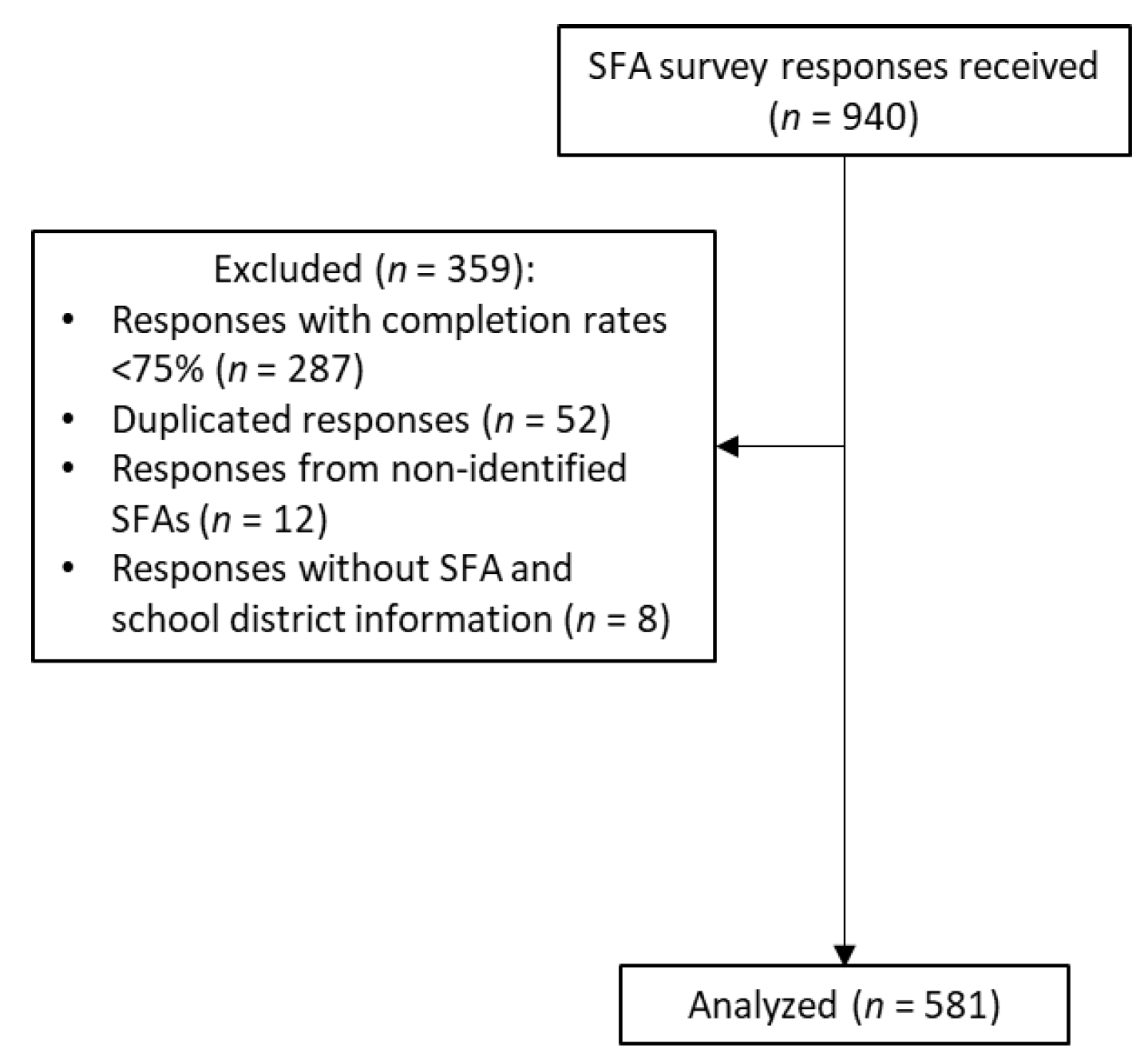
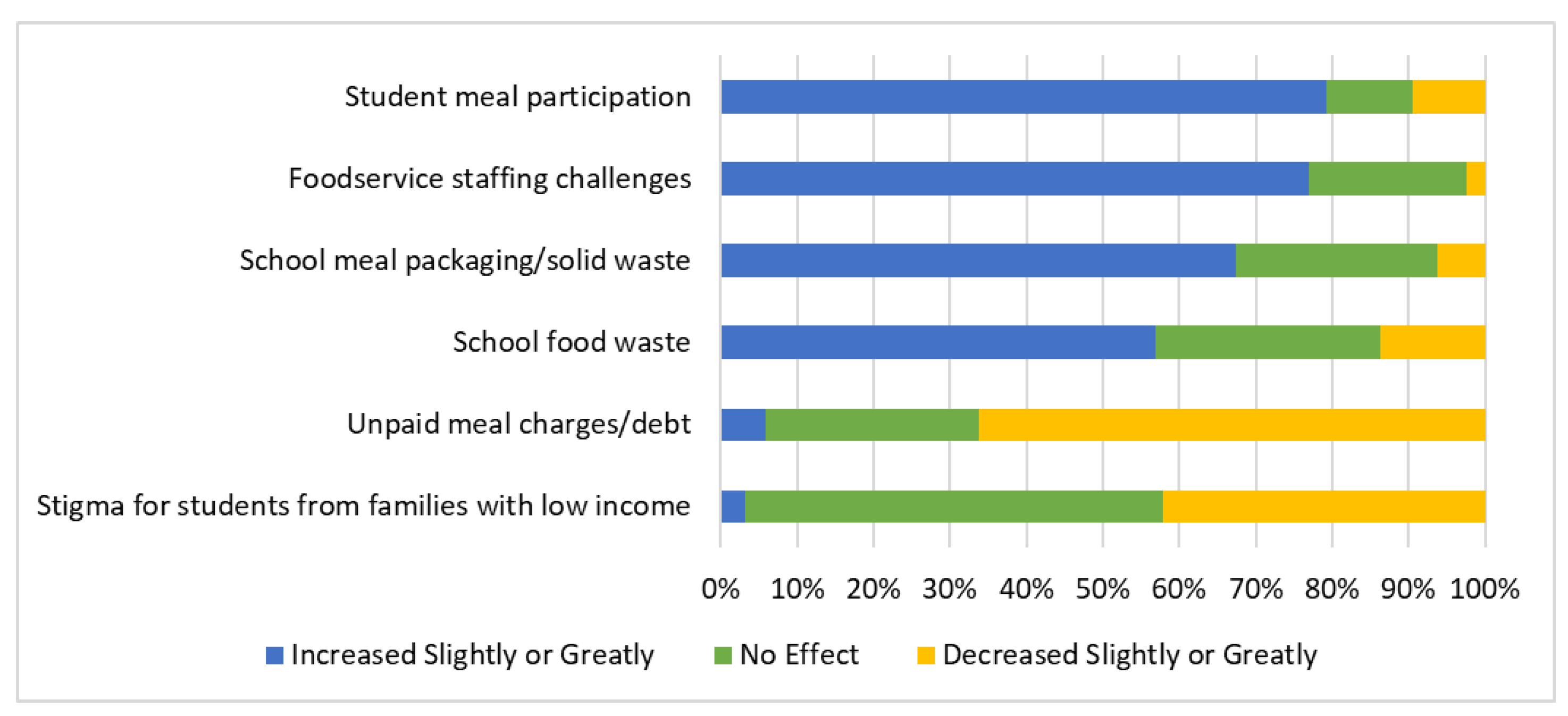

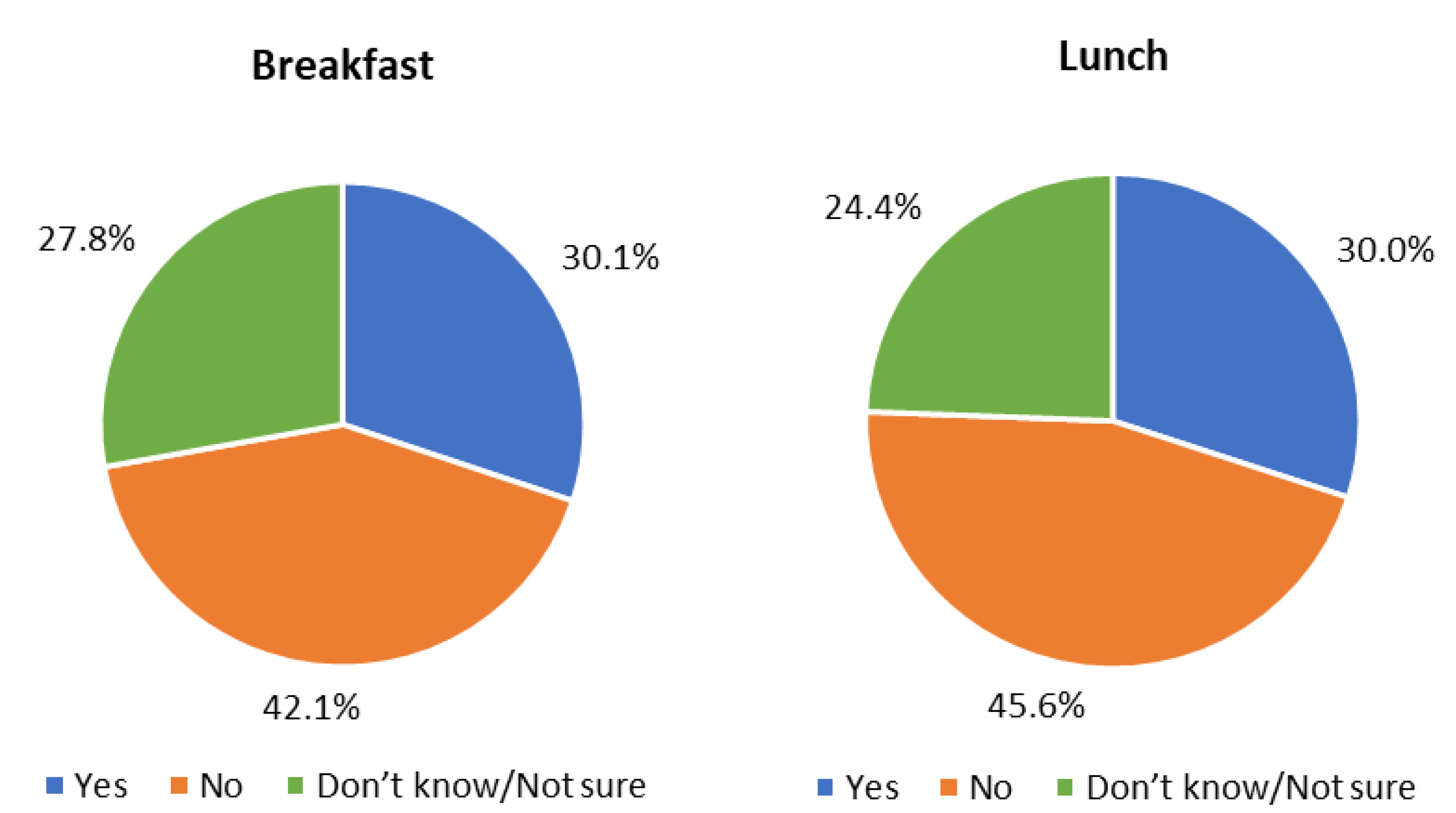
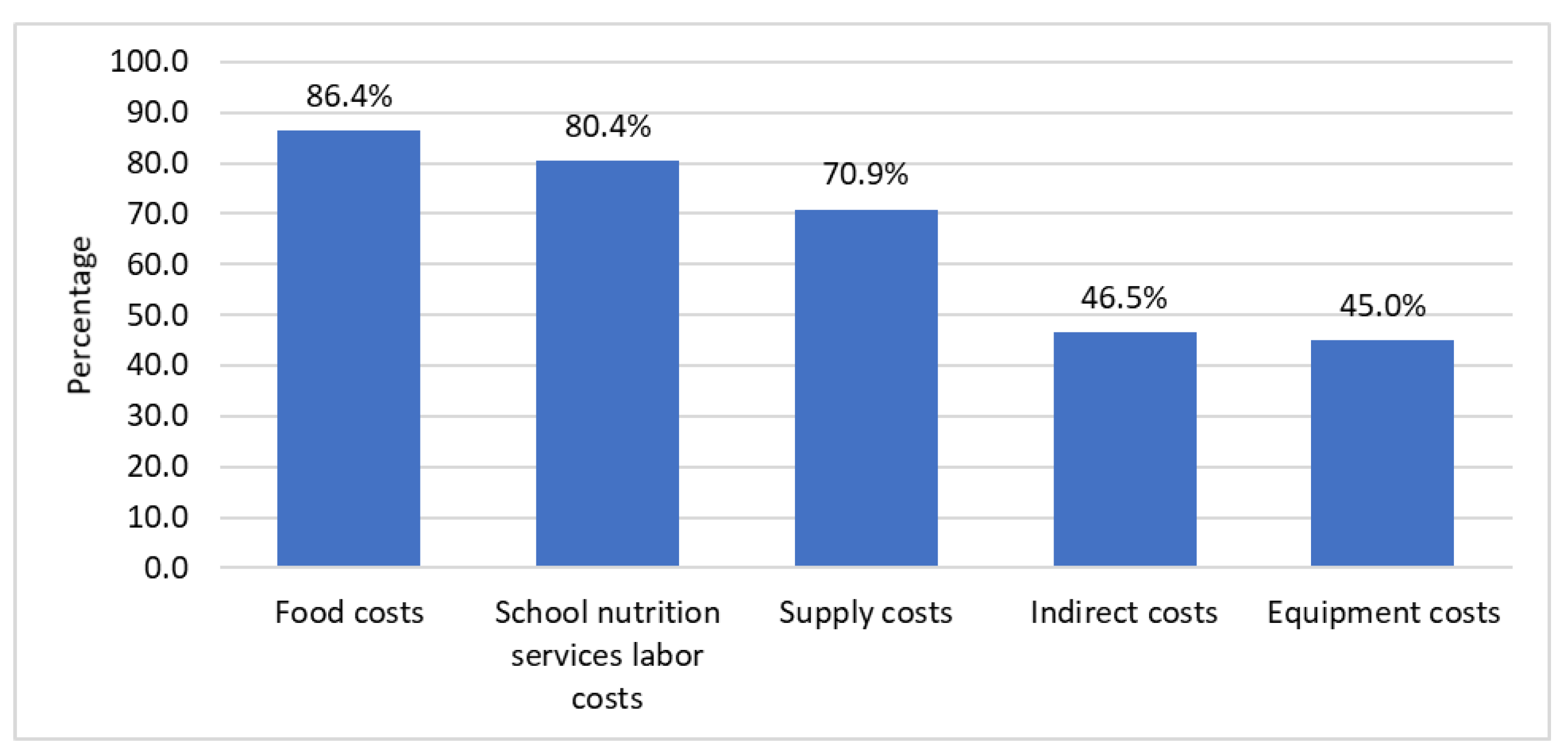
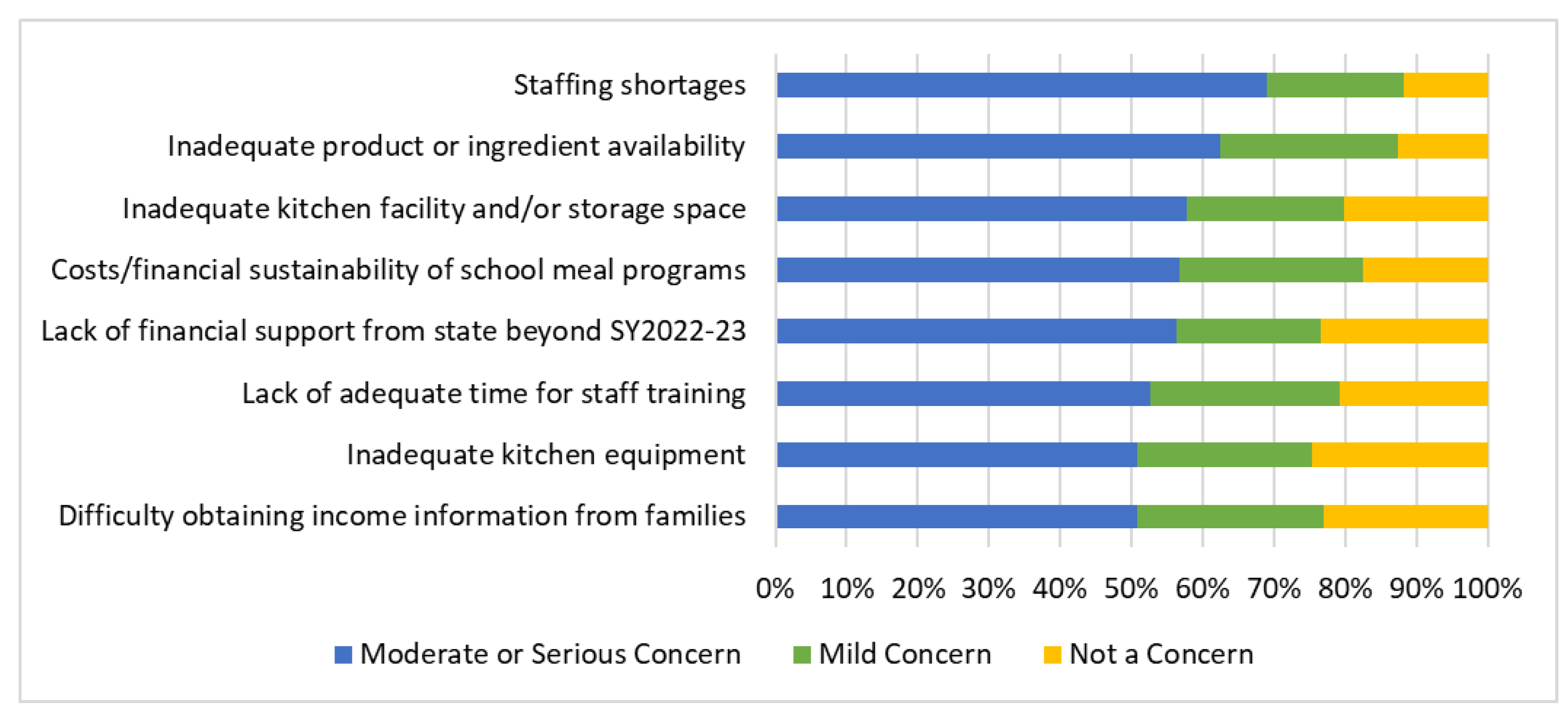
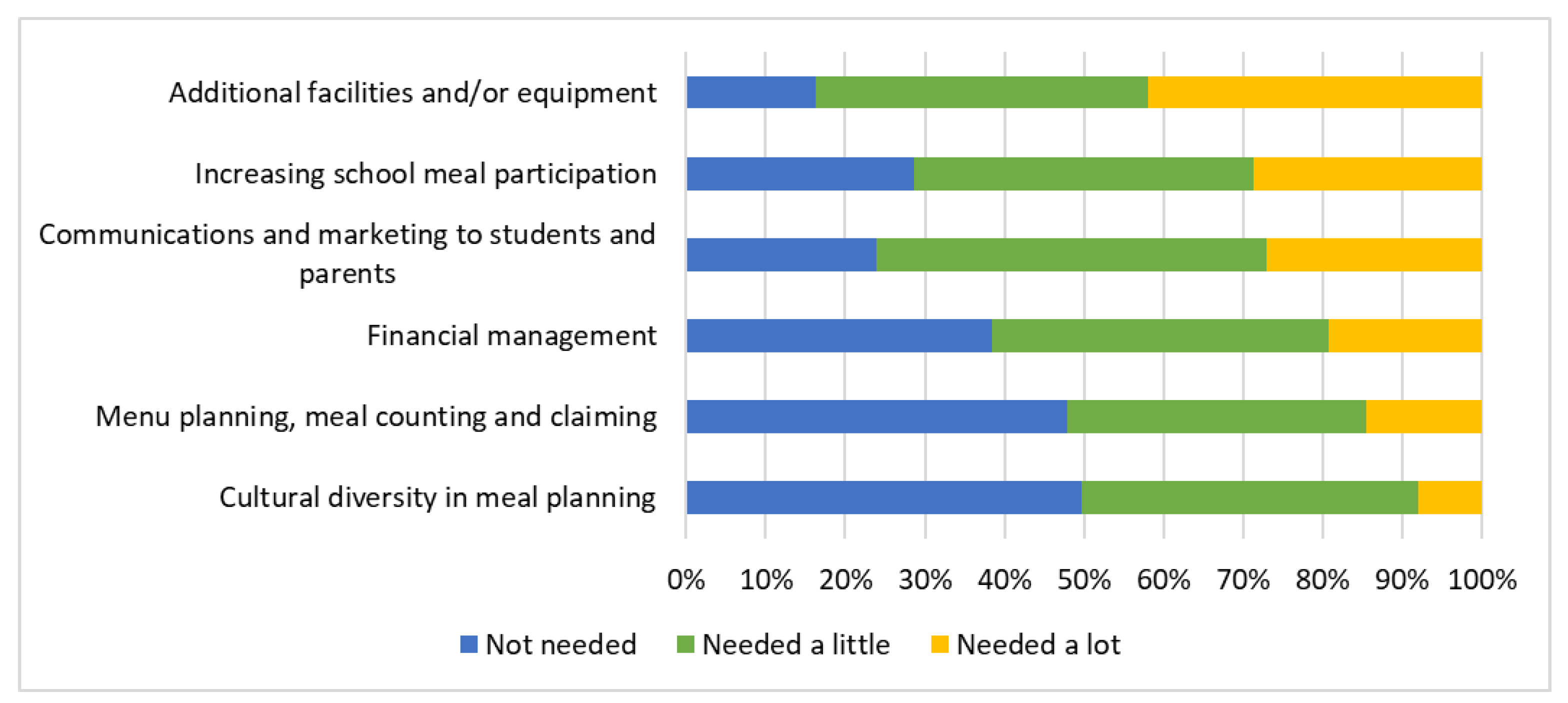
| Survey Domain | Answer Choices in the Survey | Analytical Version |
|---|---|---|
| Changes due to USM in the SY 2021–22: Survey question 28 * | “decreased greatly”, “decreased slightly”, “no effect”, “increased slightly”, and “increased greatly” | “increased slightly or greatly” vs. “decreased slightly or no effect” |
| Challenges implementing USM in the SY 2021–22: Survey question 27 * | “significant challenge”, “moderate challenge”, “minimal challenge”, and “not a challenge” | “moderate or significant challenge” vs. “minimal or not a challenge” |
| Concerns for the future of USM: Survey questions 30-32 * | “not a concern”, “mild concern”, “moderate concern”, and “serious concern” | “moderate or serious concern” vs. “mild or not a concern” |
| Additional resources or information needed for the SY 2022–23: Survey question 34 * | “not needed”, “needed a little”, and “needed a lot” | “needed a little or a lot” vs. “not needed” |
| Factors driving deficit in the SY 2021–22: Survey question 46 * | “yes” and “no” | “yes” vs. “no” |
| Survey Respondent Characteristics | n | % |
| Title | ||
| SFA Foodservice/School Nutrition Director | 391 | 67.3 |
| School Nutrition Supervisor/Manager | 99 | 17.0 |
| Other | 91 | 15.7 |
| Years in the role at SFA | ||
| Less than 1 year | 81 | 14.0 |
| 1–4 years | 190 | 32.8 |
| 5–9 years | 174 | 30.0 |
| 10 years or more | 134 | 23.1 |
| Years in other institutional, restaurant, or commercial foodservice | ||
| 0–4 years | 291 | 50.3 |
| 5–14 years | 120 | 20.7 |
| 15 or more years | 168 | 29.0 |
| Highest education | ||
| High school or less | 60 | 10.4 |
| Some college, no degree | 131 | 22.7 |
| Associate degree | 82 | 14.2 |
| Bachelor’s degree | 207 | 35.9 |
| Master’s degree or more | 97 | 16.8 |
| School Food Authority Characteristics in the SY 2021–22 | n | % |
| Provided universal school meals before the SY 2021–22 district-wide | 211 | 37.0 |
| Size | ||
| Small (2499 or less students) | 308 | 53.2 |
| Medium (2500–9999 students) | 160 | 27.6 |
| Large (10,000 or more students | 111 | 19.2 |
| Free and reduced-price meal eligibility | ||
| ≤40% of students | 172 | 29.6 |
| >40% of students | 409 | 70.4 |
| Urban–rural classification | ||
| Urban (RUCA primary code 1) 2 | 385 | 66.3 |
| Not urban (RUCA primary codes 2–10) | 196 | 33.7 |
| COVID-19 Waivers Implemented in the SY 2021–22 3 | n | % |
| Seamless Summer Option | 536 | 93.2 |
| Meal Pattern | 477 | 83.8 |
| Meal Service Time Flexibility | 411 | 72.9 |
| Non-congregate Feeding | 411 | 72.6 |
| Parent and Guardian Pick-up | 386 | 68.3 |
| Offer Versus Serve | 375 | 67.0 |
| Monitoring Waivers | 360 | 64.8 |
| Local School Wellness Policy Triennial Assessments | 353 | 63.4 |
| Area Eligibility | 234 | 42.7 |
| Selected Reporting Requirements | 224 | 40.7 |
| Community Eligibility | 177 | 31.8 |
| Foodservice Management | 97 | 17.7 |
| Change | FRPM Eligibility 2 | Urbanicity 3 | Size 4 | |||||||
|---|---|---|---|---|---|---|---|---|---|---|
| ≤40% (n = 145) | >40% (n = 215) | p-Value | Urban (n = 254) | Non-Urban (n = 106) | p-Value | Large (n = 180) | Medium (n = 106) | Small (n = 174) | p-Value | |
| % | % | % | ||||||||
| Changes that most reported as having increased in the SY 2021–22 5 | ||||||||||
| Student meal participation | 90.1 | 72.0 | 0.0001 | 75.8 | 86.3 | 0.04 | 76.3 | 81.1 | 79.3 | 0.68 |
| Foodservice staffing challenges | 85.9 | 71.1 | 0.001 | 78.4 | 74.4 | 0.40 | 86.3 | 88.7 | 65.5 | 0.0001 a,b |
| School meal packaging/solid waste | 75.0 | 62.4 | 0.01 | 66.9 | 68.5 | 0.78 | 69.2 | 73.6 | 62.7 | 0.18 |
| School food waste | 66.9 | 50.2 | 0.002 | 58.6 | 52.9 | 0.36 | 63.8 | 51.4 | 56.9 | 0.47 |
| Changes that most reported as having decreased in the SY 2021–22 6 | ||||||||||
| Unpaid meal charges/debt | 64.1 | 67.9 | 0.46 | 64.4 | 70.1 | 0.30 | 82.7 | 75.5 | 53.2 | 0.0001 a,b |
| Stigma for students from families with low income | 48.9 | 43.6 | 0.32 | 45.6 | 45.9 | 0.96 | 55.0 | 55.7 | 35.3 | 0.01 a,b |
| Challenge 2 | FRPM Eligibility 3 | Urbanicity 4 | Size 5 | |||||||
|---|---|---|---|---|---|---|---|---|---|---|
| ≤40% (n = 145) | >40% (n = 215) | p-Value | Urban (n = 254) | Non-Urban (n = 106) | p-Value | Large (n = 180) | Medium (n = 106) | Small (n = 174) | p-Value | |
| % | % | % | ||||||||
| Procuring or receiving the types of foods or beverages planned | 87.0 | 89.9 | 0.36 | 89.9 | 88.3 | 0.55 | 97.3 | 96.2 | 82.4 | 0.0001 a,b |
| Procuring or receiving the quantities of foods or beverages planned | 82.3 | 87.3 | 0.15 | 85.1 | 87.0 | 0.51 | 97.4 | 95.6 | 76.4 | 0.0001 a,b |
| Procuring or receiving non-food supplies or equipment needed for school meals | 78.3 | 84.1 | 0.13 | 80.1 | 85.7 | 0.08 | 98.2 | 92.3 | 71.8 | 0.0001 a,b |
| Costs/financial sustainability of school meal programs | 84.3 | 80.5 | 0.30 | 82.6 | 80.4 | 0.54 | 88.5 | 86.1 | 76.8 | 0.003 a,b |
| Adequacy of school nutrition services staffing | 76.3 | 72.2 | 0.35 | 73.8 | 72.8 | 0.79 | 89.6 | 83.3 | 62.5 | 0.0001 a,b |
| Meal service modifications or disruptions | 59.5 | 65.2 | 0.22 | 64.9 | 61.0 | 0.39 | 71.3 | 69.6 | 57.5 | 0.003 a,b |
| Meeting federal meal pattern requirements | 55.8 | 56.6 | 0.87 | 58.0 | 53.2 | 0.31 | 72.1 | 59.4 | 49.0 | 0.01 b |
| Factor 2 | FRPM Eligibility 3 | Urbanicity 4 | Size 5 | |||||||
|---|---|---|---|---|---|---|---|---|---|---|
| ≤40% (n = 145) | >40% (n = 215) | p-Value | Urban (n = 254) | Non-Urban (n = 106) | p-Value | Large (n = 180) | Medium (n = 106) | Small (n = 174) | p-Value | |
| % | % | % | ||||||||
| Food costs | 83.0 | 87.9 | 0.30 | 82.3 | 93.1 | 0.02 | 91.7 | 87.1 | 83.5 | 0.50 |
| School nutrition services’ labor costs | 77.6 | 81.5 | 0.50 | 76.7 | 86.2 | 0.07 | 87.9 | 84.4 | 75.4 | 0.14 |
| Supply costs | 61.7 | 75.3 | 0.03 | 63.8 | 82.9 | 0.001 | 78.7 | 83.3 | 60.6 | 0.001 a,b |
| Indirect costs | 46.4 | 46.8 | 0.96 | 44.6 | 50.6 | 0.40 | 58.7 | 51.5 | 38.8 | 0.09 |
| Equipment costs | 50.7 | 42.5 | 0.23 | 42.6 | 51.5 | 0.22 | 43.3 | 52.1 | 42.9 | 0.21 |
| Concerns 2 | FRPM Eligibility 3 | Urbanicity 4 | Size 5 | |||||||
|---|---|---|---|---|---|---|---|---|---|---|
| ≤40% (n = 145) | >40% (n = 215) | p-Value | Urban (n = 254) | Non-Urban (n = 106) | p-Value | Large (n = 180) | Medium (n = 106) | Small (n = 174) | p-Value | |
| % | % | % | ||||||||
| Staffing shortages | 77.1 | 65.8 | 0.01 | 69.5 | 68.3 | 0.77 | 84.8 | 83.3 | 55.9 | 0.0001 a,b |
| Inadequate product or ingredient availability | 63.4 | 63.0 | 0.94 | 61.6 | 65.8 | 0.32 | 83.2 | 76.3 | 48.9 | 0.0001 a,b |
| Inadequate kitchen facilities and/or storage space | 67.4 | 54.3 | 0.01 | 59.3 | 55.8 | 0.44 | 67.8 | 68.3 | 49.2 | 0.0001 a,b |
| Costs/financial sustainability of school meal programs | 60.7 | 54.6 | 0.19 | 57.2 | 54.7 | 0.59 | 63.8 | 59.2 | 52.2 | 0.02 b |
| Lack of financial support from state for the Universal Meals Program beyond SY2022–23 | 60.9 | 54.5 | 0.18 | 55.8 | 57.5 | 0.72 | 67.1 | 55.6 | 52.9 | 0.02 b |
| Lack of adequate time for staff training | 59.8 | 50.3 | 0.05 | 51.4 | 56.4 | 0.28 | 62.1 | 65.6 | 43.1 | 0.0001 a,b |
| Difficulty obtaining income information from families | 52.8 | 49.9 | 0.55 | 51.9 | 48.6 | 0.49 | 54.3 | 48.2 | 50.9 | 0.69 |
| Inadequate kitchen equipment | 58.3 | 48.2 | 0.04 | 50.4 | 52.6 | 0.63 | 60.0 | 58.1 | 44.2 | 0.01 a,b |
| Resource 2 | FRPM Eligibility 3 | Urbanicity 4 | Size 5 | |||||||
|---|---|---|---|---|---|---|---|---|---|---|
| ≤40% (n = 145) | >40% (n = 215) | p-Value | Urban (n = 254) | Non-Urban (n = 106) | p-Value | Large (n = 180) | Medium (n = 106) | Small (n = 174) | p-Value | |
| % | % | % | ||||||||
| Additional facilities and/or equipment | 85.0 | 83.8 | 0.74 | 83.5 | 85.3 | 0.58 | 89.3 | 89.0 | 80.0 | 0.008 a |
| Communications and marketing to students and parents | 65.8 | 80.1 | 0.001 | 75.5 | 77.8 | 0.55 | 77.8 | 83.1 | 72.3 | 0.08 |
| Increasing school meal participation | 57.1 | 76.7 | 0.0001 | 68.6 | 76.3 | 0.07 | 75.1 | 78.5 | 66.1 | 0.02 a |
| Fiscal management | 60.8 | 62.4 | 0.75 | 61.3 | 63.8 | 0.59 | 59.2 | 68.3 | 60.0 | 0.72 |
| Menu planning, meal counting and claiming | 51.3 | 52.8 | 0.75 | 55.2 | 47.4 | 0.11 | 55.2 | 54.1 | 50.8 | 0.38 |
| Cultural diversity in meal planning | 49.3 | 51.2 | 0.69 | 51.4 | 49.1 | 0.64 | 59.3 | 58.0 | 43.5 | 0.01 a,b |
Publisher’s Note: MDPI stays neutral with regard to jurisdictional claims in published maps and institutional affiliations. |
© 2022 by the authors. Licensee MDPI, Basel, Switzerland. This article is an open access article distributed under the terms and conditions of the Creative Commons Attribution (CC BY) license (https://creativecommons.org/licenses/by/4.0/).
Share and Cite
Zuercher, M.D.; Cohen, J.F.W.; Hecht, C.E.; Hecht, K.; Ritchie, L.D.; Gosliner, W. Providing School Meals to All Students Free of Charge during the COVID-19 Pandemic and Beyond: Challenges and Benefits Reported by School Foodservice Professionals in California. Nutrients 2022, 14, 3855. https://doi.org/10.3390/nu14183855
Zuercher MD, Cohen JFW, Hecht CE, Hecht K, Ritchie LD, Gosliner W. Providing School Meals to All Students Free of Charge during the COVID-19 Pandemic and Beyond: Challenges and Benefits Reported by School Foodservice Professionals in California. Nutrients. 2022; 14(18):3855. https://doi.org/10.3390/nu14183855
Chicago/Turabian StyleZuercher, Monica D., Juliana F. W. Cohen, Christina E. Hecht, Kenneth Hecht, Lorrene D. Ritchie, and Wendi Gosliner. 2022. "Providing School Meals to All Students Free of Charge during the COVID-19 Pandemic and Beyond: Challenges and Benefits Reported by School Foodservice Professionals in California" Nutrients 14, no. 18: 3855. https://doi.org/10.3390/nu14183855
APA StyleZuercher, M. D., Cohen, J. F. W., Hecht, C. E., Hecht, K., Ritchie, L. D., & Gosliner, W. (2022). Providing School Meals to All Students Free of Charge during the COVID-19 Pandemic and Beyond: Challenges and Benefits Reported by School Foodservice Professionals in California. Nutrients, 14(18), 3855. https://doi.org/10.3390/nu14183855







